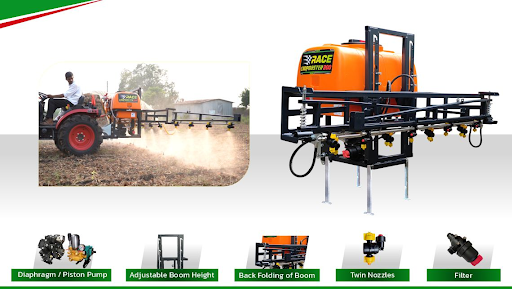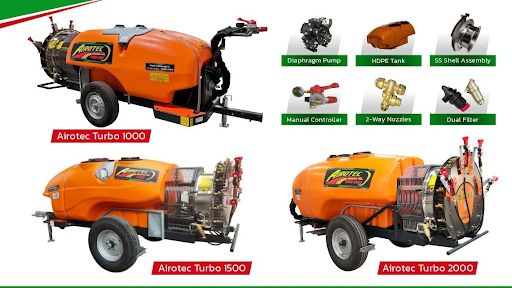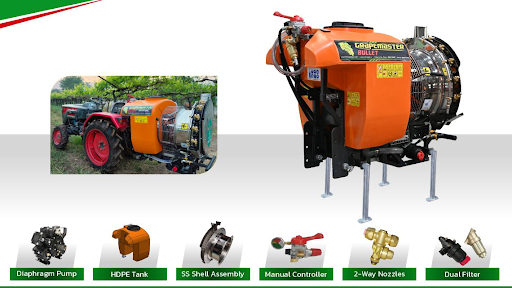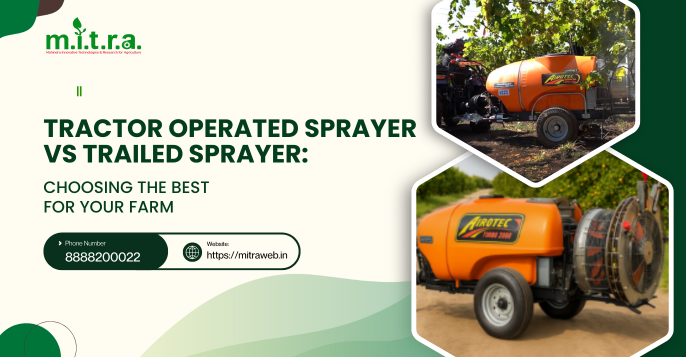Did you know that improper spraying can waste up to 30 % of agrochemicals and still leave pest hotspots? In India’s competitive horticulture and field-crop sectors, effective spraying isn’t optional, it’s essential. So how do you decide between a tractor operated sprayer and a trailed sprayer for your farm? This blog walks you through what each does, where each shines, and how MITRA’s sprayer range can help you make the right choice. We’ll compare features, show use-cases, and give you a checklist to pick smartly.

What Is a Tractor Sprayer Used For?
A tractor operated sprayer is a spray machine mounted directly on—or driven by—the tractor, often via the 3-point linkage or PTO (Power Take-Off). Its main use is in orchards, vineyards, and row crops, where precise, uniform chemical application is needed.
Farmers rely on a tractor operated sprayer to deliver pesticide, fungicide, herbicide, or nutrient sprays across trees or vines efficiently. Because it’s integrated with the tractor, you get good maneuverability, closer turning, and better control in tighter plots. The ability to fine-tune air-assisted nozzles helps ensure spray particles penetrate canopies rather than just landing externally.
For example, MITRA’s Bullet tractor mounted sprayer is designed for orchard crops including grapes, pomegranate, orange, mango, guava, and others.It uses a rear air conveyor for air balancing, has a 200 L tank, and provides uniform coverage with low power consumption.
What Is the Use of Trailed Sprayer?
A tractor trailed sprayer (often called a boom sprayer or pulled sprayer) is towed behind the tractor. It is ideal for broad-acre operations where you need high capacity, wider booms, and less frequent refilling.
The use of a trailed sprayer makes sense when your farm is large, row spacing is generous, and you want to reduce operational downtime by having more spray volume per trip. Unlike tractor operated sprayer units, a trailed sprayer can offer bigger tank capacities (e.g., 1,000–2,000 L or more), multiple nozzles over a large boom, and a more stable towing platform across flat fields.
MITRA’s Airotec Turbo series exemplifies this. Models like Airotec Turbo 1000, 1500, 2000 L are designed for orchard and intensive cropping scales. These are effectively tractor-trailled sprayer systems (or large capacity sprayer machines) that combine air-assist technology, adjustable tyres, rear air conveyor, and multi-nozzle boom setups.
Advantages of tractor operated sprayer include better control in tight spacing, flexibility, easier transport, and often lower capital cost. However, if your plot is large and you need to reduce downtime, a trailed sprayer offers advantage in throughput and reduced refill frequency.
When to Choose Which: Decision Checklist
Here’s a quick decision checklist:
- Farm size & field layout: If your farm is under, say, 50 acres or has narrow rows and irregular boundaries, a tractor operated sprayer is better. If your property is large, contiguous, and flat, trailed sprayers shine.
- Crop type: Orchards, vineyards, tree crops benefit from tractor operated air-blast systems. For broad row crops, a trailed boom sprayer can cover more ground.
- Row spacing & turning space: Tight row-to-row spacing or limited turning radius favors mounted/operated sprayers.
- Tractor horsepower: If your tractor is modest (e.g., 25–40 HP), a lighter tractor operated sprayer may suit; big trailed booms demand more horsepower.
- Budget & maintenance resources: Trailed sprayers cost more and have more parts — only invest if return in efficiency justifies it.
- Refilling constraints: If water or chemicals are remotely located, less refilling may favor trailed units.
For instance, if you run a vineyard with 3 m row spacing and lots of terraces, a tractor operated sprayer is ideal. But if you farm large flat plains with cotton or wheat, a trailed sprayer might give you faster coverage.
You can also mix systems: use a tractor operated sprayer for orchard blocks and a trailed sprayer for open field crops on the same farm.

Product Examples (With MITRA’s Range)
Let’s look at how MITRA addresses both categories:
MITRA’s Tractor Operated (Mounted) Sprayers

Mitra Bullet (Tractor Mounted Sprayer)
The Bullet series is MITRA’s signature tractor operated sprayer model. It features a 200 L tank, a diaphragm pump (55 LPM), a rear air conveyor for air balance, a 2-speed gearbox, and features to reduce chemical waste and labour.
Because it’s compact and efficient, the Bullet is well-suited for tight orchard layouts and vineyards. MITRA claims that the design can operate from tractors of 18 HP and above.

- Mitra Cropmaster / Boom Sprayer (Mounted boom type)
MITRA’s Cropmaster Reel is a tractor-operated boom sprayer (laid out on 3-point linkage). The Cropmaster Race 200L is an example: 200 L tank, 20–30 ft boom, straight-angle PTO, 55 LPM pump. Because this is still a mounted/tractor-integrated sprayer, it straddles between tractor-operated and trailed. It offers higher coverage for mid-scale field crops while maintaining the control of an integrated unit.
MITRA’s Trailed / Large Capacity Sprayers

- Mitra Airotec Turbo Series
In the tractor-trail sprayer / large-capacity category, MITRA offers the Airotec Turbo line for large-scale spraying. These models are ideally suited for high-volume coverage, combining rear air conveyors, boom sections, adjustable tyres, and dual fan/air balancing systems.
These MITRA products reflect how the concepts of tractor-operated sprayer and tractor-trailled sprayer can be applied across scales. MITRA’s strength lies in aligning the model to farm size, crop type, and budget, all while offering good after-sales support, warranty, and service networks.
Tips for Optimal Use & Maintenance
- Calibration & Nozzle Choice
Always calibrate flow and pressure to ensure you deliver the right liters per hectare. Use nozzles suited to your crop and stage, especially in air-assisted systems. - Air Balancing & Fan Speed
In air-blast sprayers (common in orchards), balancing airflow is key to push droplets into the canopy. MITRA’s rear air conveyor helps manage that. - Clean & Flush After Use
Chemical residues will degrade components. Flush lines, filters, and tank every time. - Inspect Filters & Hoses Regularly
A clogged suction filter or leak in hose causes drop in efficiency. MITRA’s designs include dual filtration systems in larger sprayers. - Maintain the Gearbox & PTO Linkages
Grease joints, check belts/chains, and ensure safe coupling. - Use Formal Safety Gear
Operator safety is critical always use masks, gloves, and eye protection. Also, ensure that pressure relief valves are in place to avoid overpressure damage. - Seasonal Maintenance & Spare Parts
Before major spray season, check nozzles, calibrate, and stock spare parts. MITRA offers support and replacement services.
Conclusion
Choosing between a tractor operated sprayer and a trailed sprayer comes down to matching your farm’s layout, size, crop type, and operational priorities. For tighter spacing and orchards, tractor operated sprayer setups provide control and agility. For large open fields, a tractor trailed sprayer with greater capacity may offer better efficiency.
If you’re exploring options, I recommend you request a demo from MITRA, whether it’s their Bullet series, Cropmaster boom sprayers, or Airotec Turbo line. Visit the MITRA website or contact their team to see which model fits your farm best and take advantage of their service, subsidy support, and reputation in Indian agriculture.
Let me know if you’d like a standalone product list comparison table, or help customising this to a specific farm setup (acreage, crop, tractor HP).
